

On November 29, 2003, a 31-year-old male volunteer fire fighter (the victim) died while fighting a basement fire in a residential structure. The victim and another fire fighter were in the basement applying water to the fire on the ceiling. A Deputy Chief in the basement reported to Incident Command that the fire was knocked down and requested ventilation. A positive pressure ventilation fan (PPV) was started at the front door as the basement windows were vented. Suddenly, thick black smoke filled the entire basement area as the hoseline became covered by debris falling from shelving in the basement. The Deputy Chief called for a Mayday as he was running out of air just after he told the crew to exit the basement. He was assisted from the structure, fell unconscious, and was rushed to a hospital. The victim’s rescue, however, was hampered by the heightened fire conditions. The victim was recovered approximately 1 ½ hours later and transported to a local hospital where he was pronounced dead.
NIOSH investigators concluded that, to minimize the risk of similar occurrences, fire departments should:
Additionally,
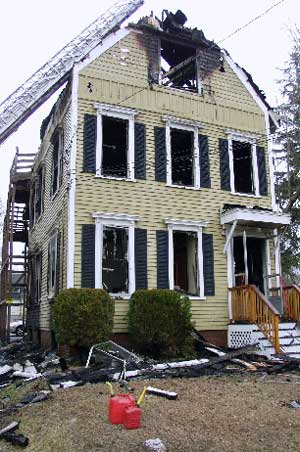 |
Incident Site |
On November 29, 2003, a 31-year-old male volunteer fire fighter (the victim) died while fighting a basement fire in a residential structure. On December 1, 2003, the U.S. Fire Administration (USFA) notified the National Institute for Occupational Safety and Health (NIOSH) of the fatality. On January 12, 2004 through January 15, 2004, three Safety and Occupational Health Specialists from the NIOSH Division of Safety Research investigated the incident. Meetings were conducted with the State Fire Marshal, Deputy State Fire Marshal, representatives from the State Fire Marshal’s Office, a representative from the State’s Fire Chiefs Association, a representative from the State’s Fire Service Commission, and representatives from the State Critical Incident Stress Debriefing Team. Interviews were conducted with officers and fire fighters who were at the incident scene. The NIOSH investigators reviewed the victim’s training records, drawings of the building, and a career department’s dispatch tapes. The victim’s department did not have written standard operating procedures (SOPs) or dispatch tapes. The incident site was visited and photographed.
Department
This volunteer fire department has 22 uniformed fire fighters in 2 stations.
It serves a population of approximately 7,500 in an area of about 28 square
miles. Volunteer fire fighters are paid an hourly rate while on duty.
Training
The State where the incident took place has no minimum training requirements
for fire fighters. The victim had more than 3 years of experience and had successfully
completed numerous training courses such as: Fire Fighter I, first responder,
search & rescue, self rescue, emergency medical technician, and pumps and
hydraulics.
Building Information
The main structure was a 2-1/2 story wood balloon-frame residence with a basement.
It was built in 1900 and had since been divided into five separate living units.
The basement area was sectioned off into rooms by cabinets and shelving with
debris and various materials throughout. It is believed the ceiling in the basement
was a suspended ceiling system with 12-inch by 12-inch composite tiles stapled
to a grid of wood furring strips.
In 1986, there were two additional 1-1/2 story wood-frame units attached to the rear of the main structure. Each of the seven units had their own natural gas meters.
The building had 5,378 square feet of living space. The residences were equipped with smoke detectors.
Weather
The National Weather Service reported that the winds at the regional airport
approximately 10 miles from the incident scene averaged over 26 mph between
0300 and 0500 hours with gusts of over 42 mph. The temperature was in the upper
30’s with scattered light rain showers.
Units for Initial Alarm
In this incident, a minimum of four volunteer and two career fire departments
were dispatched; however, only those units directly involved in operations preceding
the fatal event are discussed in the investigation section of this report.
Victim’s Department
Personally Owned Vehicle (POV) (Captain [C1])
POV (Deputy Chief [IC])
Engine 4 (Officer, driver/operator, fire fighter)
Ladder 1 (Officer, driver/operator, fire fighter)
Rescue 1 (Victim, Fire Fighter #1)
Engine 2 (Officer, driver/operator)
Mutual Aid Departments for Initial Alarm
Engine 6 - Career (Deputy Chief [DC], driver/operator, Fire Fighter #2, Fire
Fighter #3)
Engine 5 - Volunteer (Officer, driver/operator, 2 fire fighters)
POV – Volunteer (Chief [C2])
Ladder D1 - Career (Officer, driver/operator, 2 fire fighters)
On November 29, 2003, a 31-year-old male volunteer fire fighter (the victim) died while fighting a basement fire in a residential structure. At approximately 0334 hours, the local police dispatch received a call of a structure fire in a residential occupancy, and dispatched the local volunteer fire department which included Engine 4, Engine 3, Engine 2, Ladder 1, and Rescue 1. Engine 3 (E3) was out of service due to mechanical failure; therefore, the victim and Fire Fighter #1 responded in Rescue 1 (R1).
A Captain (C1) was first to arrive on the scene in his personally owned vehicle
(POV). He entered the front door to investigate and radioed the Incident Commander
(IC), who was en route, that they had a working fire with heavy smoke coming
from the basement. At approximately 0340 hours, the IC was notified by dispatch
that Engine 3 was out of service. The IC immediately told the dispatch to have
Engine 6 (E6) respond for mutual aid from a local career department. Note:
There were no alarm assignments or “Alarm Cards” for the units dispatched.
The IC had to decide on the fireground the units and departments that he wanted
to respond to the incident.
Upon arrival at the scene, the IC was told by C1 that everyone was out of the
residence. At approximately 0343 hours, the IC called dispatch to request mutual
aid from Engine 5 (E5), a volunteer company. As the IC and C1 were beginning
their exterior size-up, E6 called the IC to request orders. Note:
The career department could only communicate with the IC on the radio in their
apparatus. Their portable radios operated on a different frequency than the
department for which they were providing mutual aid. Engine 6 was now
the first due pumper, so the IC had them report to the front of the structure
upon their arrival at approximately 0344 hours. As the IC proceeded around the
B-side of the structure, it was determined that they had a working basement
fire. Rescue 1 had arrived on the scene and the IC had a face-to-face discussion
with the Deputy Chief (DC) from E6. It was decided to advance a 1 ¾-inch
handline into the basement to find and attack the seat of the fire. The victim
and Fire Fighter #1 received orders to assist the crew from E6 to advance the
line into the basement.
The DC proceeded inside the structure with a thermal imaging camera (TIC) to check conditions and search or the fire. The conditions on the first floor did not require him to go on air. The DC could see down the entire stairs leading into the basement. He donned his air mask as he went down the narrow stairwell. The hallway at the bottom of the stairs turned back toward the center of the structure and it was lined with paint cans on shelves (See Photo #1). Visibility was still good in the basement at this time. The DC opened a door to a room and there was minimal heat as the smoke banked down approximately 8 to 10 inches below the ceiling. The fire was sluggish along the ceiling coming from the C/D corner of the structure (see Diagram). The fire was in the suspended ceiling system overhead extending out from the C/D corner. Note: This ceiling system would allow the fire to spread and gases to build up undetected in the void space overhead.
The DC proceeded to the top of the stairs to communicate his findings to the IC and met Fire Fighter #2. He told Fire Fighter #2 that there was not much fire and to send down the handline. The victim and Fire Fighter #1 advanced the uncharged handline down the stairs into the basement (see Diagram). At approximately 0346, the DC called on his department’s radio for the line to be charged. The fire fighters encountered some pressure problems with the handline. The DC sent Fire Fighter #2 to check for kinks and informed Fire Fighter #3, who was stationed at the top of the stairs, not to send anyone else down because it was too crowded. Fire Fighter #2 found a kink in the hoseline on the stairs and immediately restored pressure to the nozzle. During this time, the mutual aid chief (C2) arrived on the scene.
At approximately 0348 hours, Engine 5 (E5) arrived on the scene for mutual aid. The Lieutenant from E5 received orders to place a positive pressure ventilation (PPV) fan at the front door, leave it in the off position, and conduct a primary search on the third floor. The crew proceeded up the stairs and found light smoke conditions on the second and third floors. During this time, the victim and Fire Fighter #1 were taking turns on the nozzle while the DC reported to the IC that the fire was knocked down and requested ventilation. Note: The DC had taken a radio from Fire Fighter #1 in order to communicate with the IC. Upon the DC’s request, the mutual aid chief (C2) started the PPV fan and walked around to the B-side to check the conditions. Fire fighters had already started venting the basement windows on B-side. Light colored conversion smoke flowed from the window confirming that they were hitting the fire in the basement and the water was being converted to steam.
At approximately 0350 hours the IC called and requested mutual aid from career department Ladder 1 (LD1) to provide a rapid intervention team (RIT). The Lieutenant from E5 called the IC to report all was clear on the third floor, but he did not receive a response. Note: The Lieutenant’s volunteer department had radios with channels that included the same frequency as the IC; however, the Lieutenant did not have communication with the IC due to his radio being on the wrong channel. The smoke conditions improved as they opened the windows on the third floor. They could hear the PPV fan. The crew was using a TIC searching for extension, but could not find any in the attic area or knee walls of the third floor. Note: Special attention was given to searching for extension because the house was balloon-frame construction.
Within minutes, C2 began walking back toward the front of the structure. The smoke was now black and was pushing from the basement windows. At approximately the same time, conditions deteriorated as thick black smoke was pushing from under kitchen cabinets on the third floor located in the B/C corner. Visibility was near zero on the third and second floors as they decided to exit and receive additional orders.
During this time, the victim and Fire Fighter #1 were knocking the fire down in the basement. The smoke started to lift and visibility was returning just as the DC’s low air alarm began to sound. The DC gave the TIC to one of the fire fighters on the nozzle and Fire Fighter #1’s radio to Fire Fighter #2 as he began to exit in order to change out his air bottle. The conditions immediately got worse. Thick black smoke filled the entire basement area. Note: It is believed that the crew in the basement was operating between the seat of the fire and the basement windows when the PPV fan was started and the basement windows were vented (see Diagram). As the DC was trying to exit, he had difficulty finding the hoseline because it made a loop in the small hallway at the bottom of the stairs and was covered by fallen debris. Visibility was now zero as the heat conditions became more intense. The DC told Fire Fighter #3 to abandon the basement. Fire Fighter #1 and Fire Fighter #3 exited the basement. The DC called for a Mayday at approximately 0407 hours, and again twice at 0408 hours on his department’s portable radio. With no response and out of air, the DC manually activated his personal alert safety system (PASS), removed his regulator and placed his face next to the floor to try to breathe air. As he was crawling to find the stairs, another fire fighter assisted him outside where he fell unconscious and was rushed to a hospital where he was admitted for smoke inhalation.
The Lieutenant and two fire fighters from E5 had just made their way down to the first floor when fire fighters exiting the basement stated that a fire fighter was still in the basement. The crew from E5 immediately went to the basement. One fire fighter stayed at the bottom of the stairs as the Lieutenant and the other fire fighter searched for the victim. The Lieutenant yelled for the victim to manually activate his PASS with no response. They followed the hoseline searching for the victim. Debris was falling on them and debris covered the basement floor and most of the hoseline as they searched for the victim. Blue flames approximately two feet thick rolled across the basement ceiling. Note: It is believed that two of the gas meters began to fail at this time due to the fire conditions. The Lieutenant found the victim who requested assistance as he was trying to crawl without his mask. The Lieutenant yelled to his fire fighter for assistance. The fire fighter arrived within seconds to assist the victim who was now unresponsive. The two had great difficulty trying to drag the victim to the stairs due to the mounds of debris. Once they got the victim to the stairs they both called for Mayday without any response. As they were attempting to move the victim up the stairs, the basement became engulfed in flames (see Photo #2) and they were forced to leave.
It was determined through a roll call that the victim was still in the basement.
Ladder D1 just arrived on the scene when the IC activated them as the RIT. The
RIT entered the structure and passed the E5 crew in the hallway on the first
floor who informed them that the victim was unresponsive and at the bottom of
the stairs. Once outside, the E5 crew had to immediately remove their gear which
was on fire due to the extreme heat conditions they endured as they attempted
to rescue the victim.
The RIT proceeded about halfway down the basement stairs. They were met with
extremely hot conditions and zero visibility. Flames were rolling across the
ceiling towards the stairway which was acting as a chimney. The RIT was using
a TIC, but it would not register anything due to the intense heat conditions
on the stairs. During this time the IC had called for an evacuation and sounded
the air horns.
Fire conditions in the structure became untenable. Note: At least two gas meters in the basement were compromised by the fire increasing the fire load (see Photo #3). Operations moved to defensive tactics using master streams until the gas was shut off and the fire could be controlled. The victim was recovered at approximately 0630 hours, placed in an ambulance, and transported to a local hospital where he was pronounced dead.
The medical examiner reported the cause of death as smoke and soot inhalation.
Discussion: Standard operating procedures (SOPs) should be developed addressing emergency scene operations. The SOPs for emergency operations should cover specific operations such as ventilation, water supplies, and basement fires. Basement fires present a complex set of circumstances, and it is important that SOPs are developed and followed to minimize the risk of serious injury to fire fighters. The importance of ventilation when attacking basement fires cannot be overemphasized. Fire can quickly spread upward into the structure causing potential problems such as a flashover, backdraft, or weakening of the structure. Ventilation timing is extremely important and must be carefully coordinated with both fire attack and ventilation crews. Ideally, ventilation should occur just ahead of interior crews advancing their hose lines. Properly ventilating the heat and smoke from buildings can reduce the possibilities of potentially hazardous situations for fire fighters. The fire fighters performing ventilation tasks should be in communication with the fire fighters attacking the fire or entering the structure to coordinate their efforts. The SOPs should be in written form and be included in the overall risk management plan for the fire department. If these procedures are changed, appropriate training should be provided to all affected members. The department involved in this incident did not have written SOPs at the time of the investigation.
Discussion: Chapter 10 of the Essentials of Fire Fighting, 4th edition, states that “ventilation must be closely coordinated with fire attack.” To reduce vertical extension, direct ventilation of the basement during fire attack is necessary. This can be accomplished in several ways. Horizontal ventilation can be employed to vent heat, smoke, and gases through wall openings such as doors and windows, even if the windows are below ground-level in wells. Natural pathways such as stairways can also be used to vent the basement area provided the means used to ventilate the heat and smoke do not place other portions of the building in danger. As a last resort, the basement can be vented by cutting a hole in the floor near a ground-level opening such as a door or window. The heat and smoke can then be forced from the basement through the exterior opening using mechanical ventilation.
Forced ventilation introduces air at such great volumes that it can cause the fire to intensify or spread. In this incident, the fire had already been knocked down when ventilation was requested. Horizontal ventilation was completed by knocking out the basement windows on the B-side of the structure. Horizontal ventilation does not release the heat and smoke directly above the fire; therefore, it is imperative that horizontal ventilation is coordinated with the interior attack crew to ensure that it doesn’t block their escape routes. The crew that was operating inside the basement was between the windows and the seat of the fire. When the forced positive pressure ventilation took place, they were in the direct exit path of the products of combustion.
Discussion: A Rapid Intervention Team (RIT) should be positioned to respond to every fire. The team should report to the officer in command and remain at the command post until an intervention is required to rescue a fire fighter(s). The RIT should have all the tools necessary to complete the job, e.g., a search rope, first-aid kit, and a resuscitator. The RIT team should be comprised of fresh, well-rested fire fighters, and be positioned and ready to respond when a fire fighter(s) is down or in trouble. In this incident, a mutual aid company was called to provide RIT services; however, they did not arrive until after the victim became trapped.
Discussion: NFPA 1620 provides guidance to assist departments in establishing pre-incident plans. Pre-incident planning that includes agreements formed by a coalition of all involved parties including mutual aid fire departments, emergency medical services companies, and police, will present a coordinated response to emergency situations, and may save valuable time by a more rapid implementation of pre-determined protocols.
Discussion: Mutual aid companies should train together and not wait until an incident occurs to attempt to integrate the participating departments into a functional team. Differences in equipment and procedures need to be identified and resolved before an emergency occurs where lives may be at stake. Procedures and protocols that are jointly developed, and have the support of the majority of participating departments, will greatly enhance overall safety and efficiency on the fireground. Once methods and procedures are agreed upon, training protocols must be developed and joint-training sessions conducted to relay appropriate information to all affected department members.
In this incident, a minimum of four volunteer and two career fire departments were on the scene. Coordination of fireground efforts would have been enhanced if protocol planning, communication procedures (such as radio frequency/channel selection), and training had taken place among mutual aid departments.
Additionally,
Discussion: An effective radio communication system is a key factor in fire department operations. The communication system, or central dispatch center, is used for receiving notification of emergencies, alerting personnel and equipment, coordinating the activities of the units engaged in emergency incidents, and providing nonemergency communications for the coordinating fire departments. The dispatch system must be able to identify the type and number of units due to respond to the type of incident in advance based on risk criteria and unit capabilities. Because there were not pre-determined alarm assignments, or an “alarm card,” for the units dispatched, the incident commander had to decide which units and departments that he wanted to respond to the incident. Fire communications centers should also be staffed with operators who are familiar with fire department operations and equipment. The central dispatch center could then also monitor fireground activity and inform command of time intervals or of possible missed transmissions such as Maydays. A central dispatch center equipped with regional mutual aid channels could serve multiple jurisdictions. This type of system would provide operational advantages in the communication system, reflect a more functional mutual aid system, and reduce overall costs of operating centers in individual jurisdictions. Having a pre-determined response for apparatus arranged by district, address or by type of incident, makes the Incident Commander’s and the dispatcher’s job much easier. The assignment lists the apparatus slated to respond to the incident and should take into account apparatus that are out of service by filling in for such units with similar units. In this incident, once Engine 3 was determined to be out of service, an alarm card plan would have dispatched another engine in its place.
Units responding to or engaged at incidents should have the necessary radio frequencies/channels to be in contact with other units providing mutual aid. These units should also have the capability to monitor the fireground activities while en-route. During this incident, many of the units could not communicate with the IC or the local dispatch center on either their portable or mobile radios.
This incident was investigated by Jay Tarley, Mark McFall, and Virginia Lutz, Safety and Occupational Health Specialists, Division of Safety Research, NIOSH.
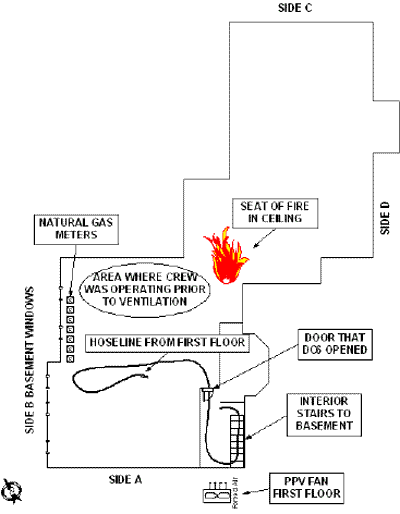 |
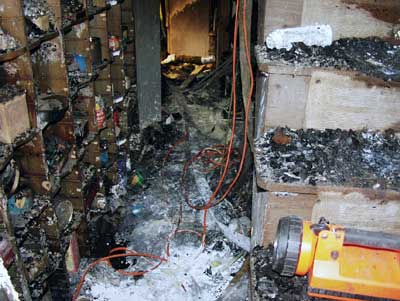 |
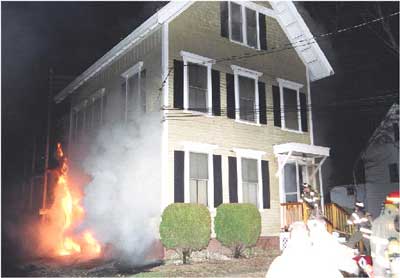 |
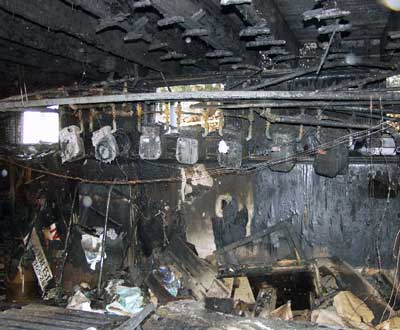 |
Photo 3. The two compromised gas meters
are on the left. |
Return to Fire Fighter Homepage
This page was last updated on 10/27/04.